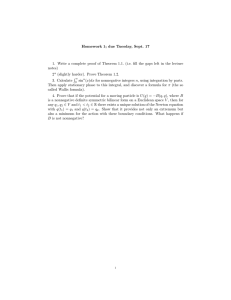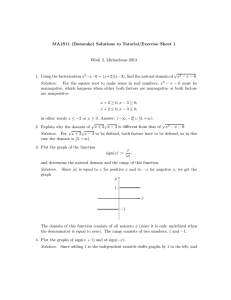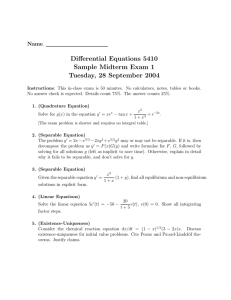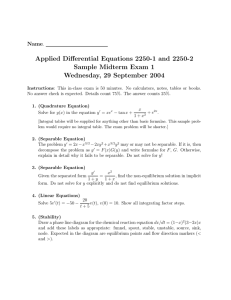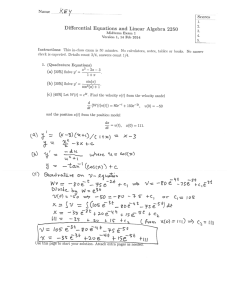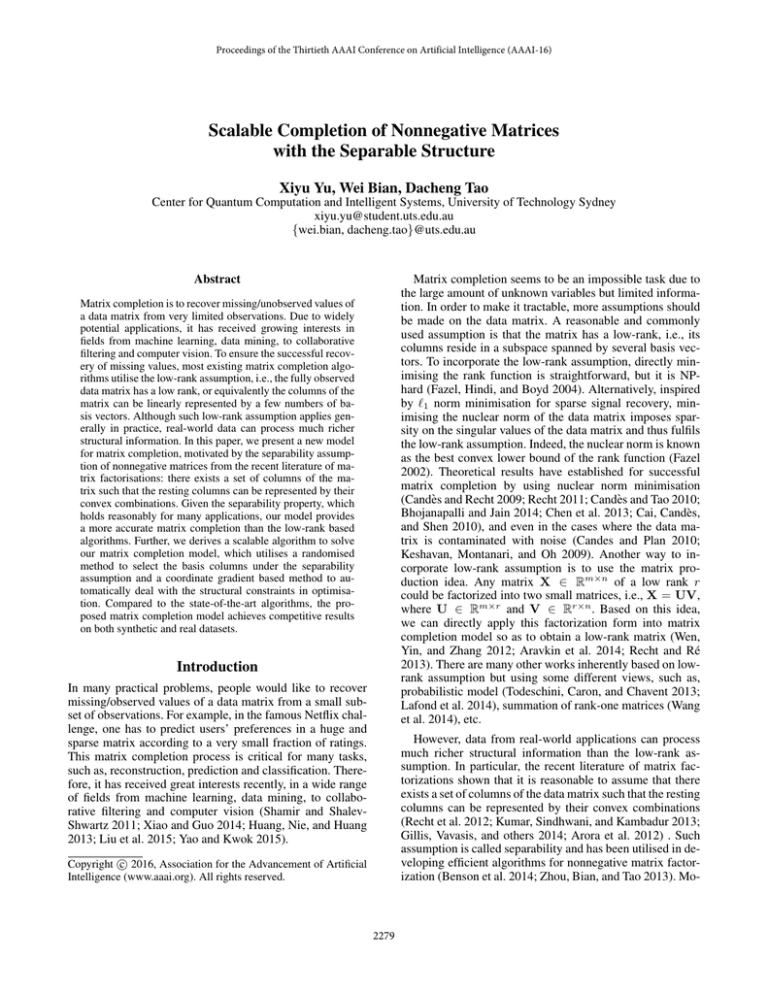
Proceedings of the Thirtieth AAAI Conference on Artificial Intelligence (AAAI-16)
Scalable Completion of Nonnegative Matrices
with the Separable Structure
Xiyu Yu, Wei Bian, Dacheng Tao
Center for Quantum Computation and Intelligent Systems, University of Technology Sydney
xiyu.yu@student.uts.edu.au
{wei.bian, dacheng.tao}@uts.edu.au
Matrix completion seems to be an impossible task due to
the large amount of unknown variables but limited information. In order to make it tractable, more assumptions should
be made on the data matrix. A reasonable and commonly
used assumption is that the matrix has a low-rank, i.e., its
columns reside in a subspace spanned by several basis vectors. To incorporate the low-rank assumption, directly minimising the rank function is straightforward, but it is NPhard (Fazel, Hindi, and Boyd 2004). Alternatively, inspired
by 1 norm minimisation for sparse signal recovery, minimising the nuclear norm of the data matrix imposes sparsity on the singular values of the data matrix and thus fulfils
the low-rank assumption. Indeed, the nuclear norm is known
as the best convex lower bound of the rank function (Fazel
2002). Theoretical results have established for successful
matrix completion by using nuclear norm minimisation
(Candès and Recht 2009; Recht 2011; Candès and Tao 2010;
Bhojanapalli and Jain 2014; Chen et al. 2013; Cai, Candès,
and Shen 2010), and even in the cases where the data matrix is contaminated with noise (Candes and Plan 2010;
Keshavan, Montanari, and Oh 2009). Another way to incorporate low-rank assumption is to use the matrix production idea. Any matrix X ∈ Rm×n of a low rank r
could be factorized into two small matrices, i.e., X = UV,
where U ∈ Rm×r and V ∈ Rr×n . Based on this idea,
we can directly apply this factorization form into matrix
completion model so as to obtain a low-rank matrix (Wen,
Yin, and Zhang 2012; Aravkin et al. 2014; Recht and Ré
2013). There are many other works inherently based on lowrank assumption but using some different views, such as,
probabilistic model (Todeschini, Caron, and Chavent 2013;
Lafond et al. 2014), summation of rank-one matrices (Wang
et al. 2014), etc.
Abstract
Matrix completion is to recover missing/unobserved values of
a data matrix from very limited observations. Due to widely
potential applications, it has received growing interests in
fields from machine learning, data mining, to collaborative
filtering and computer vision. To ensure the successful recovery of missing values, most existing matrix completion algorithms utilise the low-rank assumption, i.e., the fully observed
data matrix has a low rank, or equivalently the columns of the
matrix can be linearly represented by a few numbers of basis vectors. Although such low-rank assumption applies generally in practice, real-world data can process much richer
structural information. In this paper, we present a new model
for matrix completion, motivated by the separability assumption of nonnegative matrices from the recent literature of matrix factorisations: there exists a set of columns of the matrix such that the resting columns can be represented by their
convex combinations. Given the separability property, which
holds reasonably for many applications, our model provides
a more accurate matrix completion than the low-rank based
algorithms. Further, we derives a scalable algorithm to solve
our matrix completion model, which utilises a randomised
method to select the basis columns under the separability
assumption and a coordinate gradient based method to automatically deal with the structural constraints in optimisation. Compared to the state-of-the-art algorithms, the proposed matrix completion model achieves competitive results
on both synthetic and real datasets.
Introduction
In many practical problems, people would like to recover
missing/observed values of a data matrix from a small subset of observations. For example, in the famous Netflix challenge, one has to predict users’ preferences in a huge and
sparse matrix according to a very small fraction of ratings.
This matrix completion process is critical for many tasks,
such as, reconstruction, prediction and classification. Therefore, it has received great interests recently, in a wide range
of fields from machine learning, data mining, to collaborative filtering and computer vision (Shamir and ShalevShwartz 2011; Xiao and Guo 2014; Huang, Nie, and Huang
2013; Liu et al. 2015; Yao and Kwok 2015).
However, data from real-world applications can process
much richer structural information than the low-rank assumption. In particular, the recent literature of matrix factorizations shown that it is reasonable to assume that there
exists a set of columns of the data matrix such that the resting
columns can be represented by their convex combinations
(Recht et al. 2012; Kumar, Sindhwani, and Kambadur 2013;
Gillis, Vavasis, and others 2014; Arora et al. 2012) . Such
assumption is called separability and has been utilised in developing efficient algorithms for nonnegative matrix factorization (Benson et al. 2014; Zhou, Bian, and Tao 2013). Mo-
c 2016, Association for the Advancement of Artificial
Copyright Intelligence (www.aaai.org). All rights reserved.
2279
tivated by this, we propose a Nonnegative Matrix Completion model under Separability Assumption (NMCSA).We
derives a scalable algorithm to solve our matrix completion
model. First, a randomised method is applied to select the
basis columns of the data matrix, which overcomes the difficulty of the original combinatorial optimisation over the
basis index. We show that under mild regularity conditions,
the randomised method is able to successfully select the basis columns with high probabilities. Next, we developed a
coordinate gradient based method to optimise data matrix.
One advantages of our method is that it automatically deal
with these structural constraints of separability. In addition,
it has a closed form solution in each iteration, with only linear complexity. These features show the potentials of our
algorithm for solving large problems.
We present our model NMCSA and the optimisation algorithm in the next two sections. Then, empirical evaluations
on both synthetic and real-world data are report.
Notations: Throughout this paper, boldface uppercase
(resp. lowercase) letters, such as X (resp. x), denote a matrix (resp. vector); letters which are not bold denote scalars.
Π is a permutation matrix. For a matrix X, Xij , Xi· and X·j
respectively denote the (i, j)th element, ith row vector and
j th column vector; we may also use Xi to denote a column
vector X·i of a matrix X whenever it is appropriate. · F
denotes the Frobenius norm of a matrix; · 2 denotes the
2 norm of a vector. The set of nonnegative real number is
denoted by R+ . For a matrix, X ∈ Rm×n
(or X ≥ 0) indi+
cates that all elements in X are nonnegative. [n] denotes the
set {1, 2, · · · , n}, and | · | is the cardinality of a set. If S is a
subset of an arbitrary set, then S̄ is its complement set.
2) instead of searching an undetermined model with the basis and weights in a high-dimensional space, directly anchoring representative exemplars much reduces the complexity
of learning space. Indeed, a series of recent works have been
carried out by utilising the separability to learn succinct representations of large high-dimensional data, especially in the
direction of nonnegative matrix factorisations (Benson et al.
2014; Zhou, Bian, and Tao 2013).
However, in many application scenarios, we have only incomplete data with a very small portion of observations, like
collaborative filtering, and need to recover the unobserved
values from such limited information. In such cases, separability is still helpful as the structural constraints to restrict the freedom of unobserved values and therefore offer chances for successful completion. More importantly,
the separable property holds rationally for practical datasets.
Taking the MovieLens dataset as an example, the ratings of
an ordinary person could be represented by combination of
the ratings by typical users. Thus, albeit a large amount of
movies unrated by most users, we can still predict these ratings by limited observed information.
Specifically, in matrix completion tasks, we are given a
data matrix X that is only partially observed within a support
is incomplete version of X, i.e.,
set Ω. Denote by X
ij , ∀ (i, j) ∈ Ω,
Xij = X
The folwe intend to obtain a full recovery of X from X.
lowing uniform sampling condition on the observed entries
of X is commonly needed for matrix completion (Candès
and Recht 2009). It excludes the cases where a few columns
of X are mostly observed while the rest are almost empty.
Suppose ρ = 0.1, it implies roughly 10% of the entries of X
are observed.
Condition 1 (Uniform sampling). The incomplete version
is generated by sampling the entries of X uniformly, with
X
Bernoulli distribution B(1, ρ).
Accordingly, the completion of a separable nonnegative
can be formulated
matrix X from incomplete observation X
as the optimisation below,
1
min XΠ − XS [I F] 2F
S,Π,X,F 2
ij , ∀(i, j) ∈ Ω,
s.t. X ∈ Rm×n
, Xij = X
+
(1)
Matrix Completion Model
Given a nonnegative data matrix X ∈ Rm×n
, each column
+
of which corresponds to a data point in Rm
+ , we say X has
the separable property if the columns of X can be represented by convex combinations of its few columns, which
are called basis columns, while the basis columns cannot
be represented by the resting columns. Mathematically, we
have the following definition for separability.
Definition 1 (Separability). For nonnegative matrix X ∈
and a submatrix XS composed by its columns with
Rm×n
+
index S ∈ [n], X is separable if and only if it resides in a
convex hull generated by XS , i.e.,
r×(n−r)
FT 1r = 1n−r , F ∈ R+
∀i ∈ [n], Xi ∈ conv(XS ), XS = {Xi }i∈S ,
|S| = r.
Remarks. The matrix completion model (1) takes most
advantages of separability by using several representative
data points to recover missing values. Besides, given completed X, it also gives rise to a unique matrix factorisation
XS [I F], which can be used for further analysis, such data
clustering and visualisations.
or equivalently,
XΠ = XS [I
F]
r×(n−r)
where r = |S| and F ∈ R+
FT 1r = 1(n−r) ,
and
,
.
The separability can be interpreted that a rich dataset
could be represented by a small subset of its few exemplars therein (Mahoney and Drineas 2009; Yang et al. 2015).
Compared to the low-rank assumption, it offers additional
advantages: 1) representing dataset using several exemplar
data points results in more natural and interpretable models;
Optimisation
The separable structure makes the optimisation (1) nontrivial, and inapplicable the existing algorithms for low-rank assumption based matrix completions. The index set S of the
2280
denoting by p∗i = Pr(i = arg maxj∈[n] XT e and i ∈ S),
where e is a randomly chosen standard basis vector of Rm ,
1−ρ
+ γ,
it holds i∈S p∗i = 1. Assume mini∈S p∗i ≥ ρ(n−|S|)
for some γ > 0.
Condition 3 (Data Generation). For separable nonnegative
matrix X = XS [I F] ∈ Rm×n , the columns {Fj , j ∈ S̄}
are i.i.d. instances sampled from some distribution p(f ) over
{f : f T 1r = 1, f ∈ Rr+ }.
Note that both conditions are mild and to be hold in general. In particular, the probability requirement in Condition
2 is easy to be satisfied given large enough n, and Condition 3 nearly imposes no harsh restrictions on X. However,
the necessity of the two conditions can be interpreted as below: Condition 2 guarantees that even with incomplete ma any column {X
j , j ∈ S} has a better chance to be
trix X,
selected, while Condition 3 ensures that none of the columns
j , j ∈ S̄} has an absolutely large probability to be se{X
lected, so as to malfunction our randomised method. With
such conditions, we have Proposition 2 for the (random)
projection property for a separable nonnegative matrix with
missing entries.
Proposition 2 (Projection Property with Missing Entries).
For separable nonnegative matrix X = XS [I F] ∈ Rm×n
be its incomplete versatisfying Conditions 2 and 3, let X
sion with observation probability ρ. Then, given the projec T e onto a (uniformly selected) random standard
tion y = X
direction of Rm , if i = arg max1≤j ≤n yj , it hoilds that
Pr(i = i; i ∈ S) ≥ ρp∗i , and Pr(i = j; ∀j ∈ S̄) ≤
(1 − ρ)/(n − |S|).
Now, we are ready to present the basis selection algorithm
and main theorem for the identifiability of the basis of an
by random proincomplete separable nonnegative matrix X
jections.
Theorem 1 (Basis Selection by Random Projections).
of a separable nonnegative maGiven incomplete version X
trix X = XS [I F] ∈ Rm×n , with observation probability
ρ, let π be the statistics defined via T times projections on
randomly selected standard basis vector e of Rm , i.e.,
T
1 Te
1 i = arg max X
(2)
πi =
j
T t=1
j∈[n]
convex basis contains discrete variables that are inherently
hard to deal with; the nonnegative constraint on X and the
additional constraint to restrict F onto an r − 1 dimensional
simplex (column-wise), SF = {F : FT 1r = 1n−r , F ∈
r×(n−r)
} convey further difficulties for the optimisation.
R+
We propose to break down the whole problem into two
steps. First, we apply a randomised method to determine the
index set S of the convex basis. Although the randomised
feature gives the optimal solution in terms of probability, it
offers an extreme efficient way to address the discrete optimisation over S. Besides, we provide a theoretical justification to show that the probability of successful selection of S
is overwhelming, given mild regularity conditions. Second,
we derive scalable methods to optimise {X, F}. The methods are built upon coordinate gradient based optimisation,
and thus efficient and scalable to large problems. In addition, they are able to handle the structural constraints over
{X, F} automatically, without any projections onto the feasible set required as in general gradient based methods for
constrained optimisations.
Randomised Method for Convex Basis Selection
Our randomised method for selecting the index set S of the
convex basis is motivated by the following proposition on
the separable nonnegative matrix X. In the following analysis, we can ignore the permutation matrix for simplicity.
Proposition 1 (Projection Property). Given a separable
nonnegative matrix X = XS [I F] ∈ Rm×n , where XS ⊂
X is the convex basis with index set S, and its projection
y = XT β onto any random direction (vector) β ∈ Rm , if
i = arg max1≤j≤n yj , then it must hold that j ∈ S.
Actually, Proposition 1 is the corollary of the much general facts that the projection of a high-dimensional convex
set into a low-dimensional subspace is still a convex set and
any vertex of the latter must correspond to a vertex of the
original. Most recently, quite a few works have been done
(Zhou, Bian, and Tao 2013), by utilizing Proposition 1 to
design efficient algorithms for separable nonnegative matrix factorisations, as well as other related problems such as
learning topic models and latent variable models.
Our study further extends this direction of research to matrix completions. Note that in the completion task, matrix X
is only partially observed (with generally very few entries)
on the support set Ω. Such sparse character could lead to
a considerably poor projection property, compared to that
stated by Proposition 1 for a fully observed matrix. The key
reason is that for X with missing values, specially when such
missing-value patterns for rows of X are distinct and random, a dense random projection (i.e., with a dense random
vector β ∈ Rm ) will partially malfunction and thus unable
to capture the separable structure of X. Considering this, we
prefer a sparse random projection and in the extreme case,
the projection onto a randomly chosen standard base vector ej of Rm . And the following regularity conditions are
needed for the success of our randomised method.
It holds that
min π j > max π j ,
j∈S
j∈S̄
(3)
with probability at least 1 − |S|(n − |S|) exp(−T γ 2 ρ2 /16).
By applying Theorem 1, we have the following algorithm
for our randomised method to select the basis set S given an
incomplete separable nonnegative matrix X.
Scalable Optimisation for F and X
Given the index set S of the convex basis, the problem of
matrix completion (1) reduces to
min 21 Y − ZF2F
Y,Z,F
ij , ∀(i, j) ∈ Ω
subject to X ∈ Rm×n
, Xij = X
+
r×(n−r)
.
FT 1r = 1n−r , F ∈ R+
Condition 2 (Minimal Probability for Basis Selection). For
separable nonnegative matrix X = XS [I F] ∈ Rm×n ,
2281
(4)
Updating Z: When (Y, F) are fixed, the updating of Z
can be achieved by solving the following minimisation
Algorithm 1 Basis Selection by Random Projections
r, T
Input: X,
Output: S
1: Initialization: I = ∅
2: for k = 1 : T do
3:
randomly select standard basis vector e
Te
4:
i = arg maxj∈[n] X
j
5:
I = I ∪ {i}
6: end for
7: S ← r unique elements of I with largest occurrences
min
Z
F
1
2 Y
min
Z·t
min
− Z·t̄ Ft̄· − Z·t Ft· 2F
(10)
where Z·t̄ is the submatrix of Z excluding the t-th column,
and analogically Ft̄· . Further, due to the equality constraint
in support set Ω, we only need to optimise the corresponding
entries of Z·t in Ω̄t . Let I be the index set of unconstrained
entries of Z·t , i.e., Ω̄t , and z = Z·t (I) and A = Y(I, :
) − Z·t̄ (I, :)Ft̄· . Then, the optimisation of z is given by
− ZF2F
1
2 E
1
2 Y
subject to Z·t ∈ Rm
+ , Xij = Xij , ∀(i, j) ∈ Ω.
(5)
r×(n−r)
subject to FT 1r = 1n−r , F ∈ R+
This is a least square problem with a feasible set defined
by the r − 1 dimensional simplex (column-wise), SF =
r×(n−r)
}. Again, the gradi{F : FT 1r = 1n−r , F ∈ R+
ent descent method combined with projection onto SF will
not work preferably. Following a similar strategy of solving (9), we intend to optimise the rows of F via the coordinate gradient descent method. Unfortunately, the constraint
FT 1r = 1n−r makes no freedom for an individual row of
F given the rest. We overcome this problem by using a randomised coordinate optimisation strategy, which randomly
selects two rows of F to optimise jointly. For any two rows
Fi· and Fj· , letting E = Y−Z·ij Fij· , where Z·ij is the submatrix of Z excluding the i, j-th columns, and analogically
Fij· . We have the following minimisation
Fi· ,Fj·
(9)
Note that this is basically a nonnegative least squares problem, which can be solved by the standard gradient descent
plus projection onto the feasible set method. Albeit the theoretical guarantees for convergence, such method is considerably inefficient, as the projection step does not favour at all
the decreasing of the objective function. Therefore, we propose to solve (9) by a coordinate gradient descent method
that simultaneously deals with the nonnegative constraint.
Specifically, we optimise each of the columns of Z in a sequential way. For the t-th column of Z, we have the following minimisation,
When (Z, Y) are fixed, the optimisation
min
− ZF2F
ij , ∀(i, j) ∈ Ω.
subject to X ∈ Rm×n
, Xij = X
+
where Y = XS̄ , Z = XS , X = [Y Z] Π.
Clearly, this is a constrained minimisation over triplet
{F, Y, Z} and can be solved by alternating optimisation
methods. However, as the problem size (m, n) scales up
quickly, standard off-the-shelf algorithms can be considerably inefficient on solving (4). This can be understood by the
fact that least squares with the nonnegative and/or the simplex constraints are nontrivial even with a moderate problem
size. Therefore, we intend to derive a scalable algorithm that
solves (4) in a most probably efficient way.
Updating F:
over F reads
1
2 Y
min
z≥0
1
A − zFt· 2F
2
(11)
which enjoys a close-form optimal solution
z∗ = max{AFTt· /Ft· 22 , 0}
(12)
Given the updating rules of each element of {F, Y, Z},
problem (4) could be alternatively optimised by Algorithm
2. In Algorithm 2, convergence of each subproblem in each
iteration is time-consuming and not necessary. We need only
an improvement on the optimisation result and a decrease
of the objective function by our coordinate gradient based
method. This can also ensure the final convergence of the
whole optimisation process.
− Z·i Fi· − Z·j Fj· 2F
Algorithm 2 Scalable Optimisation for F and X
S
Input: X,
Output: X, F
S̄ , Z = X
S
1: Initialization: Y = X
2: while unconvergence do
3:
update two randomly selected rows of F by (7)
4:
update Y by (8)
5:
for k = 1 : r do
6:
update k-th column of Z by (12)
7:
end for
8: end while
9: XS̄ = Y, XS = Z, X = [Y Z] Π
(6)
subject to Fi· + Fj· = f ,
Fi· ≥ 0, Fj· ≥ 0.
where f = 1 − Σk=i,j Fk· .The optimal solution of ( 6) is
given by
(Z − Z )T (E − Z f ) ·j
·i
·i
Fj· = min
,f
Z·j − Z·i 2
+
(7)
Fi· = f − Fj·
Updating Y: Firstly, the updating of Y is trivial given
(Z, F). We can fill the missing/unobserved entries of Y using corresponding entries in ZF, i.e.,
Y(Ω̄) = {ZF}(Ω̄).
(8)
where Ω̄ is the complement of support set of Y.
2282
of the experiments, the randomised method correctly selects
the basis, and only on two experiments, it gives an error
larger than 1. However, as the matrix size increases, the errors reduce significantly. For example, for N (M ) = 600,
only on 1 out of the 50 experiments, the randomised method
gives error 1, while for N (M ) = 800, it successes on all
experiments.
0.03
0.02
0.01
0
20
40
60
80
100
120
Column Index of X̃
140
160
180
200
(a) An example of basis selection
1
0
Sampling Ratio
Error in S Selection
4
3
2
1
0
200
400
600
Matrix Size N (M )
800
0.6
0.4
0.5
0.5
0.4
0.6
0.3
0.7
0.8
10
20
30
Rank
40
(a) LMaFit
(b) Basis selection errors
50
60
0.8
0.2
0.7
0.3
0.9
0.1
0.8
0.2
1
0
0.9
0.1
5
Sampling Ratio
Statistics πi
0.04
0.7
0.3
0.6
0.4
0.5
0.5
0.4
0.6
0.3
0.2
0.7
0.2
0.1
0.8
0
0.1
10
20
30
Rank
40
50
60
0
(b) NMCSA
Figure 1: Properties of Randomised Method for Selection of
Basis Columns.
Figure 2: Phase Transistion diagrams for matrix completion
recoverability.
Empirical Evaluations
Phase Transition Analysis A benchmark method to evaluate the performance of a matrix completion algorithm
is the phase transition analysis (Candès and Recht 2009;
Wen, Yin, and Zhang 2012). In the second experiment, by
using a single phase diagram, we can test the influence
of sampling ratio and rank individually or simultaneously
on the recovery results. Here, we fix the size of matrices
to be 500 × 500, and vary the rank and sampling ratio
in the following ranges, i.e., r ∈ {5, 8, 11, · · · , 59} and
ρ ∈ {0.01, 0.06, · · · , 0.86}, according to (Wen, Yin, and
Zhang 2012). Then, 50 independent matrix completion experiments are performed for each pair (r, ρ). We declare
that a matrix is successfully recovered if the relative error
X−Xopt F
is less than 1e-3, where X is the ground truth
XF
and Xopt the result of completion. The experimental results
are shown in Figure 2. Each color cell of the phase diagrams
corresponds to the recovery rate for each pair (r, ρ). White
means perfect recovery of all matrices of 50 experiments
while black means all failed. As shown in this figure, compared to LMaFit (Wen, Yin, and Zhang 2012), NMCSA has
a better capability of recovering separable matrices with a
wider range of ranks and sampling ratios.
To demonstrate the effectiveness of NMCSA for completing matrices with separable structures, we conduct empirical
valuations both on synthetic and real datasets. We also compare NMCSA with state-of-the-art methods for low-rank
based matrix completions, including APGL (Toh and Yun
2010) and LMaFit (Wen, Yin, and Zhang 2012).
Synthetic Data Experiments
In this section, we use synthetic data to verify the effectiveness of randomised method to find convex basis and evaluate the recovery performance of the proposed algorithm.
The synthetic data matrices in these experiments are generated in the form X = XS [I F] Π. The entries of XS and
F are generated by i.i.d. uniform distribution in [0,1] at first,
and then their column are normalized to have unit l1 norm.
In this case, the data matrix automatically has normalized
rows.
Basis Selection In the first experiment, we try to justify
the validity of the randomised method for basis selection,
i.e., with high probabilities, the method is able to find the
convex basis of a separable nonnegative matrix. We randomly generate an incomplete matrix of size 200×200, with
parameters rank r = 20 and sampling ratio ρ = 0.15. We
count the frequency of each column being identified as basis columns in all projections and check whether the true
basis vectors occupy with highest frequencies. Figure 1(a)
shows an example from one experiment. We can see that
the basis columns, which correspond to the first 20 columns
of the matrix, have the highest frequencies, and thus the randomised method success in selecting the basis columns. Further, we increase the size N and M of the matrix from 200
to 800, and rerun the experiment 50 times for different size
settings. Figure 1(b) shows the statistics of errors for basis
selection. We can see that for size N (M ) = 200, on most
On Large Problems Next, we evaluate the performance
of the proposed NMCSA on larger matrix completion problems, and compare it with the state-of-the-art algorithms,
LMaFit (Wen, Yin, and Zhang 2012) and APGL (Toh and
Yun 2010). Following the same experimental settings (Cai,
Candès, and Shen 2010), we fix the sampling ratio ρ = 0.2,
and vary the matrix size N (M ) from 1000, to 5000 and
10000, and the rank from 10, to 20 and 50. The parameters
for different algorithms are set as below: for APGL, tol =
10−4 , μ = 10−4 , truncation = 1, and truncation gap =
100; for LMaFit, est rank = 1, tol = 10−4 , and K be
1.25r or 1.5r (Wen, Yin, and Zhang 2012). All the experiments are performed in Matlab on a desktop computer.
Table 1 shows the results for performance comparison. One
2283
(RMSE), calculated on the support set Ω,
(i,j)∈Ω |Xij − Mij |
NMAE =
(rmax − rmin )|Ω|
can see that NMCSA outperforms its competitors LMaFit
and APGL consistently on all experiments.
Table 1: Recovery Error for Large Problems.
Incomplete Matrix
Size N (M ) Rank r
10
1000
20
50
10
5000
20
50
10
10000
20
50
and
Computational Results
APGL
LMaFit NMCSA
3.645e-04 3.149e-04 2.649e-04
6.496e-04 8.208e-04 6.718e-04
1.245e-01 1.567e-01 3.512e-02
3.922e-04 2.154e-04 9.989e-05
3.477e-04 3.139e-04 1.804e-04
4.023e-03 3.330e-03 3.184e-04
1.599e-04 1.792e-04 9.998e-05
1.852e-04 2.247e-04 1.226e-04
4.321e-04 4.615e-04 2.518e-04
RMSE =
Σ(i,j)∈Ω (Xij − Mij )2
|Ω|
where rmax and rmin are the lower and upper bounds for the
ratings. For Jester dataset, rmax = 20, and rmin = 0; for
MovieLens, rmax = 5, andrmin = 1. |Ω| is the cardinality
of the support set.
The parameters for the used matrix completion methods are set as below (Wen, Yin, and Zhang 2012):
for APGL, tol = 10−4 , μ = 10−4 , truncation =
1, and truncation gap = 20, while for LMaFit,
est rank = 2, tol = 10−3 , K = 1, and rk inc = 2. Table 3 and 4 show the experimental results on the Jester and
the MovieLens datasets. Note that our method NMCSA outperforms consistently its competitor, APGL and LMaFit, on
both datasets. We believe this is because the separable structure offers more information than the low-rank assumption
for the recovery of missing/unobserved data in these two
datasets.
Table 2: Recommendation Dataset Statistics.
Dataset
Dim
Sampling ratio
Jester-1
24983 × 101
0.7247
Jester-2
23500 × 101
0.7272
Jester-3
24938 × 101
0.2474
Jester-all
73421 × 101
0.5634
MovieLens-100K 943 × 1682
0.0630
MovieLens-1M
6040 × 3706
0.0447
MovieLens-10M 71567 × 10677
0.0131
Table 3: Performance of Matrix Completion on the Jester
Dataset (NMSE/RMSE).
Jester-1
Jester-2
Jester-3
Jester-all
APGL
0.0919/3.3708
0.0921/3.3948
0.0969/3.4945
0.1568/4.388
LMaFit
0.1149/3.9858
0.1133/3.7868
0.1157/3.8446
0.1151/3.9750
NMCSA
0.0874/3.1797
0.0899/3.2931
0.0928/3.7397
0.0900/3.3115
Table 4: Performance of Matrix Completion on the MovieLens Dataset (NMSE/RMSE).
Real Data Experiments
APGL
LMaFit
NMCSA
100K 0.1204/0.8707 0.1504/1.0949 0.1011/0.7493
1M 0.1415/0.9615 0.1479/0.9850 0.0973/0.9541
10M 0.1245/0.8581 0.1355/0.8338 0.0986/0.9632
We further evaluate NMCSA on two real datasets, Jester1
and MovieLens, for collaborative filtering. Both datasets are
benchmarks and have been commonly used in the literature
for matrix completions. It has been noticed that completing
the missing/unobserved entries of these datasets are considerably challenging, because of the very large problem scales
and the relatively low sampling ratio. Table 2 summaries the
basic information of the two datasets.
As no test data are available in these datasets, a common choice is to sample the available ratings by 50% for
training and use the resting 50% for test (Wang et al. 2014;
Aravkin et al. 2014). To evaluate the performance of completion, we use two measures, the Normalized Mean Absolute Error (NMAE) and the Root Mean Square Error
Conclusions
In this paper, we have proposed a novel matrix completion
model for recovering matrices with the separable structure.
By using the separability rather than the low-rank assumption, our model exploits richer structural information of realworld data, and achieves better matrix completion results
when the separability applies. A scalable algorithm is derived to optimise the proposed model. We use a randomised
method to select basis columns of the data matrix and a coordinate gradient based method to automatically deal with
the structural constraints from the separability. On both synthetic and real-world datasets, our model achieves competitive performances compared to the state-of-the-art matrix
completion methods.
1
The ratings of Jester dataset are from -10 to 10, which is not
nonnegative. In the experiments, we make a shift by adding 10 to
each entry of the data matrix. Note that such manipulation does not
affect the geometric structure of the dataset, and thus the separability should still hold.
2284
Acknowledgments
Lafond, J.; Klopp, O.; Moulines, E.; and Salmon, J. 2014.
Probabilistic low-rank matrix completion on finite alphabets. In Advances in Neural Information Processing Systems, 1727–1735.
Liu, M.; Luo, Y.; Tao, D.; Xu, C.; and Wen, Y. 2015. Lowrank multi-view learning in matrix completion for multilabel image classification. In Twenty-Ninth AAAI Conference on Artificial Intelligence.
Mahoney, M. W., and Drineas, P. 2009. Cur matrix decompositions for improved data analysis. Proceedings of
the National Academy of Sciences 106(3):697–702.
Recht, B., and Ré, C. 2013. Parallel stochastic gradient
algorithms for large-scale matrix completion. Mathematical
Programming Computation 5(2):201–226.
Recht, B.; Re, C.; Tropp, J.; and Bittorf, V. 2012. Factoring
nonnegative matrices with linear programs. In Advances in
Neural Information Processing Systems, 1214–1222.
Recht, B. 2011. A simpler approach to matrix completion.
The Journal of Machine Learning Research 12:3413–3430.
Shamir, O., and Shalev-Shwartz, S. 2011. Collaborative
filtering with the trace norm: Learning, bounding, and transducing. In COLT, 661–678.
Todeschini, A.; Caron, F.; and Chavent, M. 2013. Probabilistic low-rank matrix completion with adaptive spectral
regularization algorithms. In Advances in Neural Information Processing Systems, 845–853.
Toh, K.-C., and Yun, S. 2010. An accelerated proximal
gradient algorithm for nuclear norm regularized linear least
squares problems. Pacific Journal of Optimization 6(615640):15.
Wang, Z.; Lai, M.-J.; Lu, Z.; Fan, W.; Davulcu, H.; and Ye,
J. 2014. Rank-one matrix pursuit for matrix completion.
In Proceedings of the 31st International Conference on Machine Learning (ICML-14), 91–99.
Wen, Z.; Yin, W.; and Zhang, Y. 2012. Solving a lowrank factorization model for matrix completion by a nonlinear successive over-relaxation algorithm. Mathematical
Programming Computation 4(4):333–361.
Xiao, M., and Guo, Y. 2014. Semi-supervised matrix completion for cross-lingual text classification. In Twenty-Eighth
AAAI Conference on Artificial Intelligence.
Yang, T.; Zhang, L.; Jin, R.; and Zhu, S. 2015. An explicit
sampling dependent spectral error bound for column subset
selection. In Proceedings of The 32th International Conference on Machine Learning (ICML-15), 135–143.
Yao, Q., and Kwok, J. T. 2015. Colorization by patch-based
local low-rank matrix completion. In Twenty-Ninth AAAI
Conference on Artificial Intelligence.
Zhou, T.; Bian, W.; and Tao, D. 2013. Divide-and-conquer
anchoring for near-separable nonnegative matrix factorization and completion in high dimensions. In Data Mining
(ICDM), 2013 IEEE 13th International Conference on, 917–
926. IEEE.
This research is supported by Australian Research Council
Projects (No: FT-130101457 & No: DP-140102164); and
the Chancellors Postdoctoral Research Fellowship of the
University of Technology Sydney.
References
Aravkin, A.; Kumar, R.; Mansour, H.; Recht, B.; and Herrmann, F. J. 2014. Fast methods for denoising matrix
completion formulations, with applications to robust seismic
data interpolation. SIAM Journal on Scientific Computing
36(5):S237–S266.
Arora, S.; Ge, R.; Kannan, R.; and Moitra, A. 2012. Computing a nonnegative matrix factorization–provably. In Proceedings of the forty-fourth annual ACM symposium on Theory of computing, 145–162. ACM.
Benson, A. R.; Lee, J. D.; Rajwa, B.; and Gleich, D. F. 2014.
Scalable methods for nonnegative matrix factorizations of
near-separable tall-and-skinny matrices. In Advances in
Neural Information Processing Systems, 945–953.
Bhojanapalli, S., and Jain, P. 2014. Universal matrix completion. In Proceedings of the 31st International Conference
on Machine Learning (ICML-14), 1881–1889.
Cai, J.-F.; Candès, E. J.; and Shen, Z. 2010. A singular
value thresholding algorithm for matrix completion. SIAM
Journal on Optimization 20(4):1956–1982.
Candes, E. J., and Plan, Y. 2010. Matrix completion with
noise. Proceedings of the IEEE 98(6):925–936.
Candès, E. J., and Recht, B. 2009. Exact matrix completion via convex optimization. Foundations of Computational
mathematics 9(6):717–772.
Candès, E. J., and Tao, T. 2010. The power of convex relaxation: Near-optimal matrix completion. Information Theory,
IEEE Transactions on 56(5):2053–2080.
Chen, Y.; Bhojanapalli, S.; Sanghavi, S.; and Ward, R.
2013.
Coherent matrix completion.
arXiv preprint
arXiv:1306.2979.
Fazel, M.; Hindi, H.; and Boyd, S. 2004. Rank minimization and applications in system theory. In American Control
Conference, 2004, volume 4, 3273–3278. IEEE.
Fazel, M. 2002. Matrix rank minimization with applications.
Ph.D. Dissertation, Stanford University.
Gillis, N.; Vavasis, S.; et al. 2014. Fast and robust recursive
algorithms for separable nonnegative matrix factorization.
Pattern Analysis and Machine Intelligence, IEEE Transactions on 36(4):698–714.
Huang, J.; Nie, F.; and Huang, H. 2013. Robust discrete
matrix completion. In Twenty-Seventh AAAI Conference on
Artificial Intelligence.
Keshavan, R.; Montanari, A.; and Oh, S. 2009. Matrix completion from noisy entries. In Advances in Neural Information Processing Systems, 952–960.
Kumar, A.; Sindhwani, V.; and Kambadur, P. 2013. Fast
conical hull algorithms for near-separable non-negative matrix factorization. In Proceedings of The 30th International
Conference on Machine Learning, 231–239.
2285

